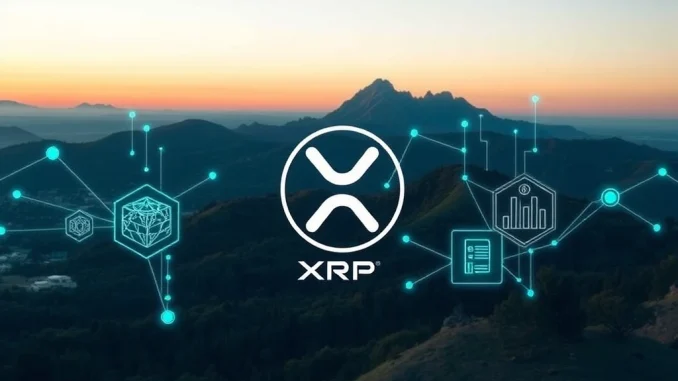
A significant development is unfolding in the world of finance and blockchain. Guggenheim Treasury Services, a key subsidiary of the renowned Guggenheim Partners, has taken a bold step by launching Guggenheim Digital Commercial Paper (DCP) directly onto the XRP Ledger (XRPL). This move signals growing confidence among traditional financial giants in leveraging blockchain technology for sophisticated financial instruments.
Understanding Guggenheim Digital Commercial Paper
So, what exactly is this Guggenheim Digital Commercial Paper? It’s a form of short-term, unsecured promissory note issued by Guggenheim Treasury Services. What makes it unique is its digital format, issued and managed on the blockchain.
- Backed By: Crucially, this DCP is backed by U.S. Treasuries, providing a layer of security and familiarity for investors.
- Target Audience: It’s specifically designed for qualified Institutional Crypto buyers, indicating a focus on large-scale, sophisticated investors rather than retail participants.
- Platform: The management of the DCP is handled via the Zeconomy platform, which presumably provides the necessary infrastructure for issuance, trading, and settlement on the ledger.
- Maturities: The paper offers custom maturities, giving institutional buyers flexibility, with terms available for up to 397 days.
This initiative represents a tangible example of traditional financial products being reimagined for the Digital Assets era.
Why the XRP Ledger?
The choice of the XRP Ledger for this issuance is noteworthy. While many blockchain networks exist, XRPL has positioned itself as a platform suitable for enterprise and institutional use cases, particularly for payments and asset tokenization. Its key characteristics include:
- Speed and Efficiency: XRPL is known for fast transaction speeds and low costs, which are essential for high-frequency financial activities.
- Reliability: The ledger has a long operational history, providing a level of proven stability.
- Focus on Assets: XRPL has built-in features designed to support the issuance and management of various types of Digital Assets.
Guggenheim’s decision suggests they found the XRP Ledger to meet the technical and operational requirements for issuing and managing a product like Digital Commercial Paper for an Institutional Crypto audience.
The Institutional Angle: Why This Matters for Institutional Crypto
This launch isn’t just about a new product; it’s a significant indicator for the broader Institutional Crypto landscape. When a firm like Guggenheim, known for its expertise in traditional finance and investments, enters this space with a blockchain-based product, it lends credibility and signals a potential shift in how institutions will interact with financial markets in the future.
For qualified institutional buyers, accessing Guggenheim Digital Commercial Paper on XRPL could offer benefits such as:
- Potential for Faster Settlement: Blockchain can enable near-instantaneous settlement compared to traditional systems.
- Increased Transparency: Transactions recorded on a public ledger can offer greater visibility (while maintaining necessary privacy for participants).
- Operational Efficiencies: Managing assets digitally can streamline processes and reduce manual overhead.
This development highlights the increasing convergence of traditional finance and blockchain technology, driven by the demand from Institutional Crypto participants seeking efficiency and innovation.
Joining the Tokenization Trend: Tokenized Treasuries
The issuance of DCP backed by U.S. Treasuries on XRPL is also a clear example of the growing trend towards Tokenized Treasuries and other real-world assets (RWAs). Tokenization involves issuing a blockchain token that represents a claim on an underlying asset, in this case, U.S. government debt.
Why are Tokenized Treasuries gaining traction?
- Accessibility: Tokenization can potentially make these assets more accessible or easier to transfer and manage within digital markets.
- Liquidity: While this specific product targets institutions, tokenization in general can enhance liquidity by enabling easier trading.
- Collateral: Tokenized assets can potentially be used as collateral in decentralized finance (DeFi) or other digital market applications.
Guggenheim’s move validates the potential of Digital Assets to represent traditional financial instruments, opening up new possibilities for how these assets are issued, managed, and traded.
What Does This Mean for the Future?
The launch of Guggenheim Digital Commercial Paper on the XRP Ledger is more than just a single product release. It signifies:
- Increased adoption of public blockchain networks by major financial institutions for core financial activities.
- Growing demand for Tokenized Treasuries and other RWA tokenization.
- The evolving landscape of Institutional Crypto, moving beyond just cryptocurrencies to include tokenized traditional assets.
While challenges like regulatory clarity and widespread adoption remain, this step by Guggenheim is a strong signal of intent and a potential catalyst for further innovation in the space where traditional finance meets Digital Assets.
Conclusion
Guggenheim Treasury Services’ issuance of Guggenheim Digital Commercial Paper on the XRP Ledger is a landmark event. It brings a traditional, trusted asset class – U.S. Treasuries – into the world of Digital Assets via tokenization, specifically targeting Institutional Crypto buyers. This move underscores the increasing relevance of blockchain technology for mainstream finance and highlights the potential for Tokenized Treasuries to become a significant part of the digital asset ecosystem. It’s a revolutionary step forward in bridging the gap between traditional financial markets and the innovative world of blockchain.



